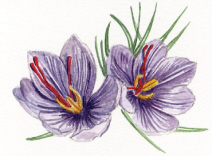

Growing saffron
Between June and August the saffron (Crocus sativus) corms (underground swollen stem bases) bought in February can be planted. They like to live in sunny, sheltered places; they dislike shade. You will need 9–10in (23–25cm) deep pots. Fill them with organic multipurpose compost plus a handful or two of homemade compost, worm casts and a sprinkling of pelletized chicken manure. For those who have pH soil testers (used to measure the soil’s acidity) the pH level should be about seven. The addition of a little lime may help the soil to reach this level, or use ground eggshells (see page 44).
The corms are planted 6in (15cm) deep and 4in (10cm) apart to give them space for reproduction. All the above measurements are just right for containers. Between planting time and September the corms won’t object to being on the dry side (remember the other places where they flourish, such as Kashmir and Spain). In September, they will need watering to help the roots grow. In October the first shoots will appear – the right month to have something to look forward to when most other plants are dying down. The soil has to reach a temperature of 41°F (5°C) in order to shock the corms into flowering. This is similar to oyster mushrooms, which also need the shock of coldness to persuade them to fruit – hence their sojourn in the refrigerator (see page 155). What is this need for iciness before fruition?
Flowering should continue for about three weeks. The suppliers of the corms say that it is better to pick the flowers when they are closed, as the saffron will be more intense. In Spain they are picked when open. The drying of the stigma, quite a simple process, is described in a booklet that accompanies the corms – or the La Mancha method could be tried (see page 110).
After flowering ceases, the leaves continue to flourish. From November until April corm reproduction takes place. In May, after all the activity of flowering, producing leaves and reproducing the corms, the leaves die. The plants then need a rest and a retreat. The corms become dormant, their development suspended. Is this similar to the hibernation of animals, when animation is suspended, and to our sleep, which suspends most activity? But when sleep is interspersed with dreams it can hardly be called dormant. Are these three periods related? If so, perhaps more is going on at this time in plants, animals and us than we know.
It is during the dormant period that, every four years, the corms should be lifted, the old ones removed and the new ones sorted, cleaned and dried, ready for replanting.
The first year’s flowers are apt to be a bit sparse, but in the second and third year, as the corms increase in number, so should the flowers.
1. February: order saffron corms.
2. June–August: plant corms.
3. September: water containers to encourage the roots to grow. Look up saffron recipes.
4. October: flowers and leaves appear. Harvesting and drying. First taste. Harvesting may continue into November.
5. November–April: leaves still green, corms reproducing.
6. May: leaves dying down. Corms become dormant, sleeping. Do not disturb.
7. May, four years later: lift corms, clean, sort and dry.
8. June: the story begins again.
Horticultural shepherding
At this time of year everything is gaining momentum, making one realize how short summer is and how important it is to observe it and take note. This is the month that contains one of the loveliest, yet one of the saddest, days, 21 June, the summer solstice and the longest day, whose next-door neighbour, 22 June, begins the descent towards the winter solstice and the shortest, darkest day. However, to cheer oneself up, don’t forget that the next-door neighbour of the winter solstice begins the ascent towards spring.
As you are a kind of horticultural shepherd, each day needs to be checked for what is happening and to make certain that all is well. For example, in one 27 x 8 x 8in (70 x 20 x 20cm) window-box grows a row of rocket, a row of ‘Sprite’ beans, a row of perpetual spinach and a row of ‘Catalogna’ lettuce, which equals thirty-six plants all needing different attention. Tomatoes now require supporting with canes; their in-between shoots (the shoot between the main stem and side shoot) need to be removed to stop them from pushing all their energy into becoming bushes. At the same time cover the tips of all the support canes with silver foil to prevent damaging your eyes (tall Lilium regale stems make good supports). When securing stems to support canes, use old-fashioned twine: it is softer and gentler on stems than plastic or metal.
Some small plants may be a bit leggy. Whether the following suggestion is horticulturally correct or incorrect, I don’t know. But it works. With a dibber (a hand tool with a pointed end for making holes) gently remove a leggy plant from the soil and replant it a little deeper to make it more comfortable. I emphasize ‘gently’ because quite a few television gardeners handle plants rather roughly, just plonking them into a hole and shovelling the soil around as though there’s no time to spare. Kittens or Spode china wouldn’t be treated in this way. The dibber is one of the most useful of window-box gardening tools. Mine is a variation on the theme, between a generous Stilton spoon and a shoehorn for narrow feet. By placing it into the soil and moving it backwards and forwards, you create a pocket into which you can slip a small plant. If dwarf French beans and ‘Salad Bowl’ lettuce have been sown in the same box, the big butterfly-shaped leaves of the beans and the bosky lettuce may be creating too much shade: trim a few of the lower bean leaves and nibble-prune the largest lettuce leaves to make more light.
Always try to water plants before ‘watering’ yourself with a breakfast coffee or an evening drink. Most plants can’t turn on taps.
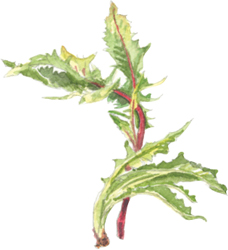
Confession number two: the pond
Having a pond opens your eyes to other ponds, one of which (situated in a well-known garden) I was passing after having installed mine. And ‘passing’ is what I should have continued doing. Covering this pond’s surface was a thick bright green plant, so dense that at first it appeared to be solid: a flat surface covered with bouclé-knitted lichen. I endeavoured to convince myself that the pond was suffering from overcrowding and that a very little light pruning of this plant (equal to about a tablespoon) wouldn’t do any harm and might do some good. Aware that what I was doing was more akin to stealing than pruning, I was relieved that I didn’t fall into the pond while committing this act. It was so tempting that I was about to step on to it. Fortunately my forefinger discovered that beneath the knitting was a pond. I slipped the ‘pruning’ into my handbag, wondering how it would survive the waterless journey home and the handbag environment.
As soon as I got back, I immediately placed the ‘pruning’ (called ‘Stolen Goods’) in the tub-pond, where it made a remarkable recovery … a bit too remarkable, because now, only a few weeks later, the thimbleful is mounting the sides of the pond and threatening to submerge the lily pads.
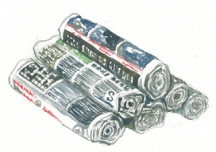
Making logs
This Royal Borough’s (free) Kensington and Chelsea Times not only converts into plant pots, can be added to compost and also used as a wormery ‘blanket’. Then there is another useful job for it, and this is to be recycled into logs for burning on a fire. It is just the right size, 15 x 12in (40 x 30cm). Any unglossy newspaper may be used – it doesn’t have to be royal. As soon as the weather becomes warmer (the ‘logs’ need to dry in the sun) the log-making can begin.
First you need to buy a Log Maker (see page 170, I) which will mould the newspaper into a log shape. Most of the work is done by the papers, water and sun. All that the human log-maker has to do is to fold about five newspapers horizontally, and place them inside a full-sized seed tray with no drainage holes – or any other similarly shaped container into which they will fit. While pressing them down, fill the tray with water until the newspapers are submerged and have stopped bubbling. After a short time (just a few minutes – though they can be left for longer) they will be saturated.
Remove a folded, soaked paper and, with the fold on the left, roll it up moderately tightly. Take a second folded newspaper and, with the fold on the right, roll this one round the first roll. Putting the folded end first on the left and then on the right produces a sturdier, more even log. Continue doing this until the Swiss-roll-ish newspapers are the right size to push into the Log Maker. Now follow the instructions for pressing down and squeezing out the water. I stand on the Log Maker for a few seconds until the water has stopped oozing. Remove the ‘log’ and put it somewhere where it can drain, stay sheltered from rain and dry out in the sun. The logs are ready when they are lightweight. Squirrel them away for the fire-burning months. These building-brick-sized logs, approximately 9 x 4 x 3in (23 x 10 x 7.5cm), take about five minutes to make but will burn for an hour.
Remedies
Procrastination Before doing something unpleasant – for instance, filling in income-tax forms or ironing shirts – take a few minutes to examine an individual plant. The eyes will be refreshed, something new will enter the mind and the disliked work will become less onerous. Gardening is also a good remedy for those who are apt to be glued to the past. There is very little time for the past in gardening – it is a present-tense occupation, the future contained within it.
Crossness If you do not feel your usual charming self, repeat the procrastination remedy, but for a bit longer, depending on the degree of crossness, which after a short time disappears. If it doesn’t, do some gardening. I have tested this and have been assured by friends and relations that it works – though how the plants feel afterwards is another matter.
Tiredness When feeling tired or listless, do a little gardening, indoor or out: it revives the weary and seems to produce energy. I am in no doubt that there is something healing about working with plants. They restore equilibrium and peacefulness (see note on horticultural therapy, page 159). Is there any other activity that, in return for a little time and attention, gives back so much?
Runner bean watch
The bean heads are slowly rising now, becoming vertical after only eight days. (Although they resemble heads, they are the original beans, but much bigger now after having absorbed water.) Anchored by the invisible root inside the soil, the neck-like stems force their way out between the opening bean. The stems are thick, sturdy and sappy, unlike other seedling stems.
After a few more days the seed coats that covered and protected, but which are now too small to fit the swollen ‘head’, wrinkle and drop off like discarded sunhats. Only a few days ago the sunhats were tough, shiny and resilient.
Two days later: the stem is growing taller and with it, on either side, two plump arm leaves, which are not leaves but larders that will eventually shrivel and drop off. They contain all the nourishment needed for this stage in a bean’s life.
Salad seeds’ germination diary
21 June On the morning of the longest day, I sowed some cut-and-come-again-salad leaves in a flowerpot base 3¼in (8cm) deep by 12in (30cm) in diameter in which I had made a few drainage holes.
23 June, p.m. Pinhead-size spots of green are visible on the soil after only a matter of hours.
Place the pot somewhere you pass frequently so that you can keep an eye on this germination drama and jot down what happens. It is most enjoyable to go outside to check on the seeds and then come inside and continue writing their diary – it makes me feel like a horticultural Boswell.
24 June, a.m. The pinheads have already divided into two oval shapes.
24 June, 2 p.m. The leaves are now revealing the minuscule white stems to which they are attached.
The arrival of these green specks has caused upheavals in the soil, as though something beneath it is heaving it up – which it is. One can almost see the specks grow. This is only a slight exaggeration.
It is astonishing that something that can only be measured in millimetres is so strong.
Question: what provides a huge amount of pleasure yet costs almost nothing? Answer: a packet of 2,000 vegetable seeds (who does the counting?), price 90p. The thin little seed packet contains expectation, potential, excitement, interest, and pleases four of the six senses.
26 June Now a central leaf vein is visible. With their two leaves stretched out horizontally (perfect tables for raindrops to balance on) the seedlings resemble a troupe of miniature athletes, exercising.
It is just as interesting and exciting to watch a seed germinating as it is to see the plant at the height of its maturity and beauty.
I look forward to getting up and seeing what has happened during the night and moonlight.
27 June A bit of squabbling is taking place; the seedlings are pushing each other aside, trying to reach light and space. They resemble rush hour on the underground.
The horizontal leaves are now growing upwards, like palms about to applaud.
29 June The leaves are thickening.
30 June, a.m. Barely visible, except through a magnifying glass, between the two outstretched leaves is a third growth, of what must be the beginning of the third leaf.
30 June, p.m. The potential third leaf is beautifully folded. Plants are the very best of packers; nothing could be gift wrapped more perfectly than the flower of the salad pea (Pisum sativum).
The surface of the youngest leaf feels like down or velvet. Does this softness help it to slide between the parent leaves?
1 July, 7 a.m. The tips of the two outer leaves have developed heart-shaped dips. The third leaf ’s velvety surface is disappearing as it grows, though it is still small enough to measure on half a centimetre of ruler.
2 July, a.m. The still folded third leaf is now taller and larger than its parent leaves. What was once smooth edged is now deckle edged.
2 July, p.m. The almost heart-shaped parent leaves are now dwarfed by their deckle-edged offspring, rather like human families.
7 July The adolescent seedlings have now become a miniature bright green copse through which it must be delightful for creatures such as beetles and ladybirds to amble.
Now the first deckle-edged leaf has appeared, others follow quickly, while the parent leaves stretch out almost horizontally, launched into becoming fully fledged lettuce.
Different seeds germinate in different ways. For instance, spinach emerges with its neck bent and looped, the seed head in the ground. If you are unable to keep animals, the next best thing is to sow seeds and look after the plants. You will feel quite different about seeds you have sown and looked after rather than something bought at a garden centre.
Cooking
When the time comes to take a bowl and knife and cut a selection of perpetual spinach, Swiss chard and pak choi, it seems almost unbelievable, when remembering the seeds rattling in their packets just a couple of months ago.
Before harvesting, bring three pots of water to the boil. Never let freshly picked vegetables wait for water to boil. Let the water wait for the vegetables, for it is more accustomed to waiting between rocks and in streams. For this first tasting, at least, cook – or rather blanch – each vegetable separately; avoid a muddle of flavours. If chemical pesticides haven’t been used there’s no need to wash the vegetables; the boiling water will do that. Don’t dilly-dally between picking and cooking (i.e. no telephone calls). And the last ‘don’t’: don’t add salt.
Lower the leaves into the gently bubbling water and, as soon as they turn an even more brilliant green, lift them out with a strainer. This first tasting needs no butter, oil, salt or pepper. It is sufficiently delicious naked, uncontaminated by other distracting flavours. For instance, if salt is added to Swiss chard its slightly sea-ish taste is masked.
The first of the dwarf French beans should also be ready to eat. Snip them off with scissors or a knife rather than fingertips, as this causes less damage. There is no need to top, tail or string them. Again, don’t add salt and don’t cover the pan or their loud popping won’t be heard. When the popping stops – after about three minutes – scoop out and eat. There is a particular sweetness about just-picked beans.
Since writing this, I have become very keen on steaming and now much prefer it to boiling. Vegetables can be semi-steamed, which leaves them with more texture.
The natural sweetness in vegetables and fruit (particularly that of melons) is always surprising. From where does it come? It is worth remembering that fruit and vegetables also contain the taste of the different weather they have encountered: spring and midsummer sunshine, a variety of rains, frost and slithers of lightning. (There was a distinct taste of hail in a wine I once drank whose grapes had been bombarded by strong storms.)
 Seeds to sow now, outdoors
Seeds to sow now, outdoors
Chicory ‘Sugar Loaf ’
Pak choi ‘Canton Dwarf ’ and ‘Joi Choi’ F1 – or sow in August
Scarole ‘Cornet de Bordeaux’
Plant saffron (Crocus sativus) corms
WHAT TO EAT NOW
Clotted cream and saffron ice cream
¼ pint (150ml) double cream (not too thick, pourable)
Small pinch of saffron (about twenty strands; a large pinch will give a bitter taste)
2 egg yolks
1½–2oz (40–50g) vanilla sugar (less sweet is preferable, allowing the saffron to have prominence)
Pinch of salt
¼ pint (150ml) clotted cream
Place the double cream and saffron in a saucepan over a moderate heat and bring to boiling point. With a wooden spoon beat together the yolks, sugar and pinch of salt. Pour this mixture into the heated cream and stir until the back of the spoon becomes coated. Do not boil or the mixture will separate. Remove from the heat and leave until cold, stirring occasionally to prevent a skin from forming. Fold the clotted cream into the custard. Pour this mixture into an ice-cream maker. If not using one, pour into a sturdy polythene container and cover with a lid. When the mixture is partially frozen, stir with a fork until smooth and refreeze until firm.
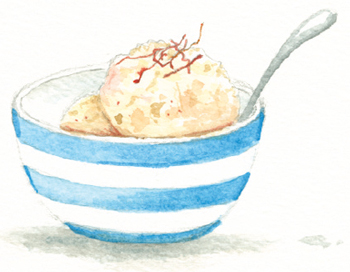
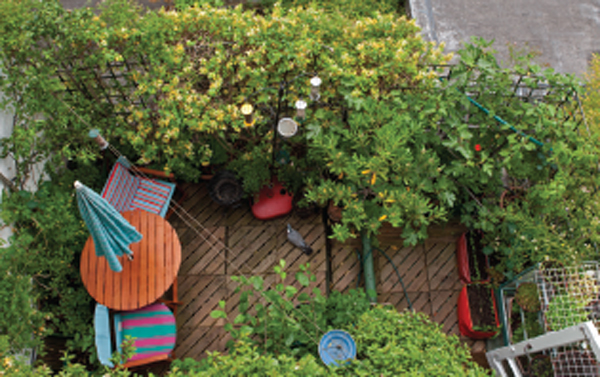
Aerial view of garden, pigeon, table and chairs.
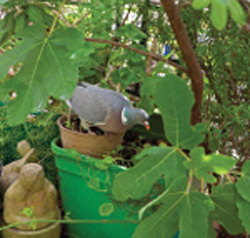
Pigeon inspecting figs, watched by stone nude.
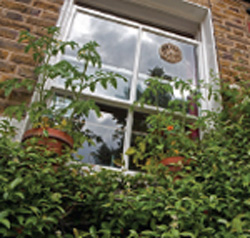
Bedroom window with tomato plant ‘curtains’.
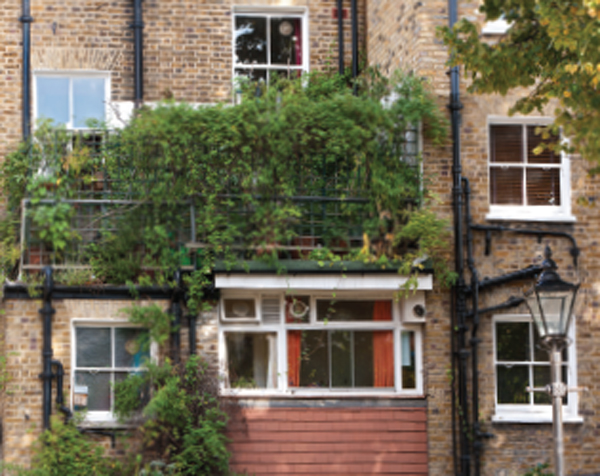
Rear view, smothered in honeysuckle, runner beans and jasmine.
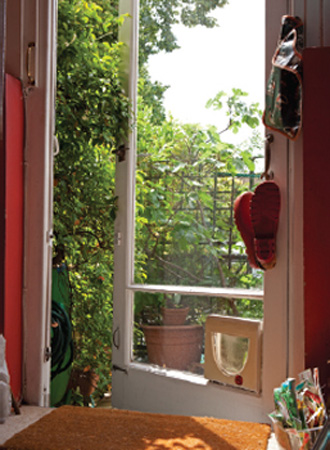
Door on to roof garden, showing cat’s flap and gardening galoshes.
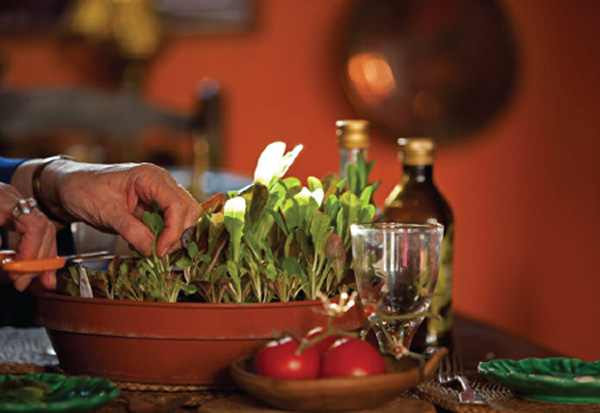
Harvesting salad on dining-room table.
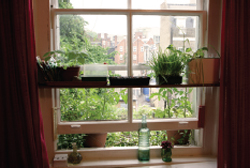
Bedroom window greenhouse.
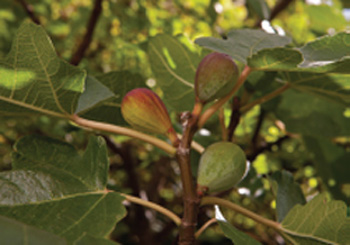
Figs ripening.
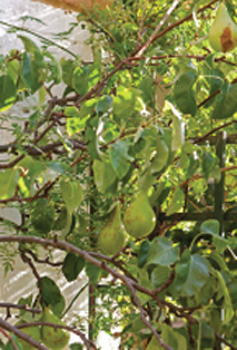
‘Conference’ pears.
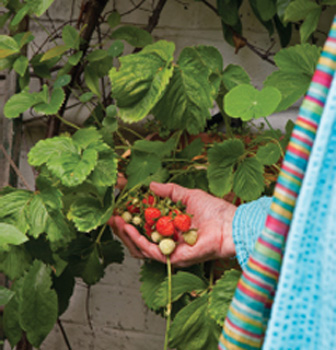
Strawberries.
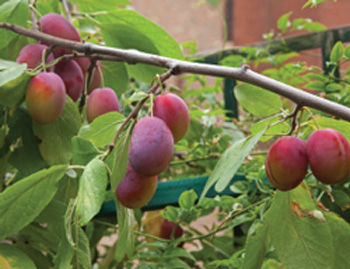
‘Victoria’ plums.
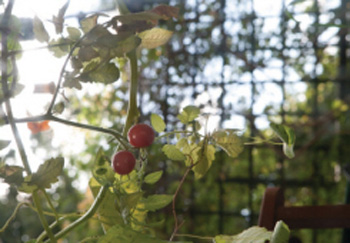
Tomatoes.
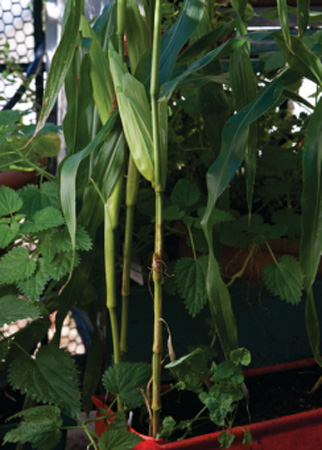
Sweet corn.
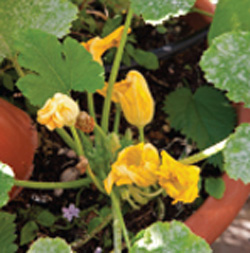
Courgette.
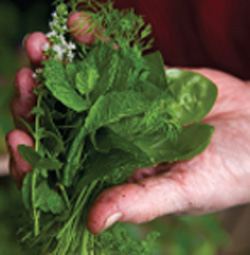
Herb harvest of dill, mint, and basil.
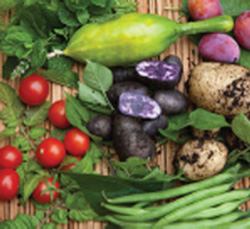
Harvest of tomatoes, beans, cucumber, ‘Maori’ and Scottish potatoes and plums.

Cat’s grass ‘lawn’.
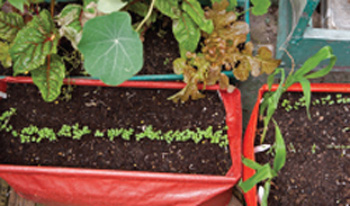
Spinach germinating.
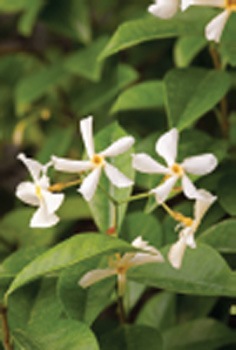
Jasmine (Trachelospermum jasminoides).
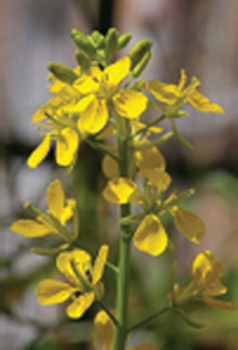
Salad flower.
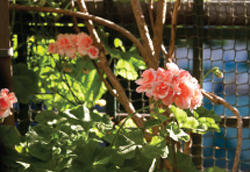
Geraniums.
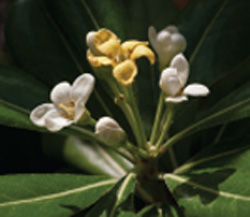
Cretan flowers.
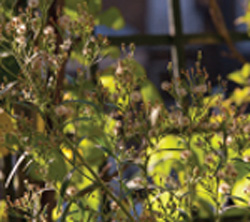
Salad flowers.